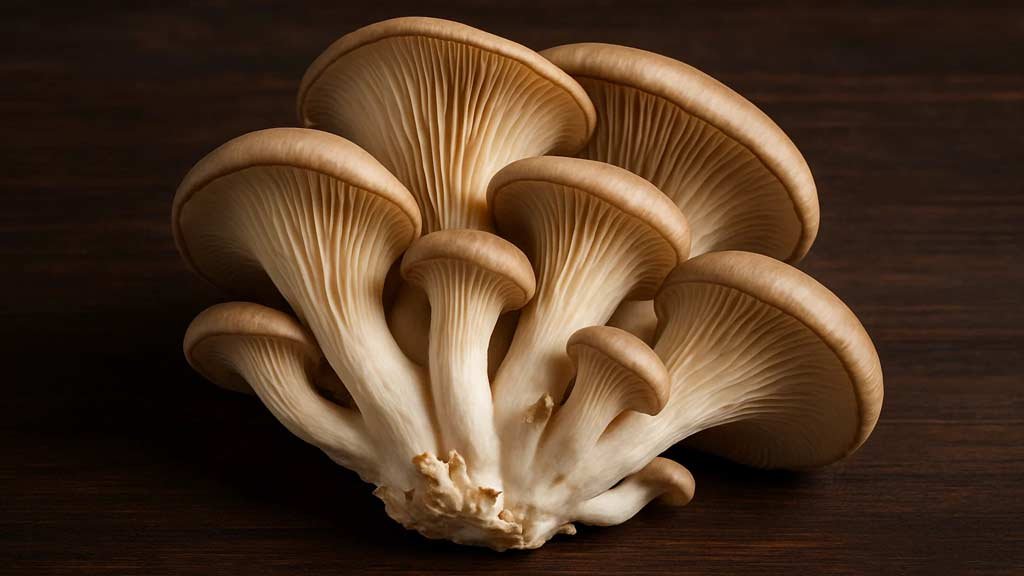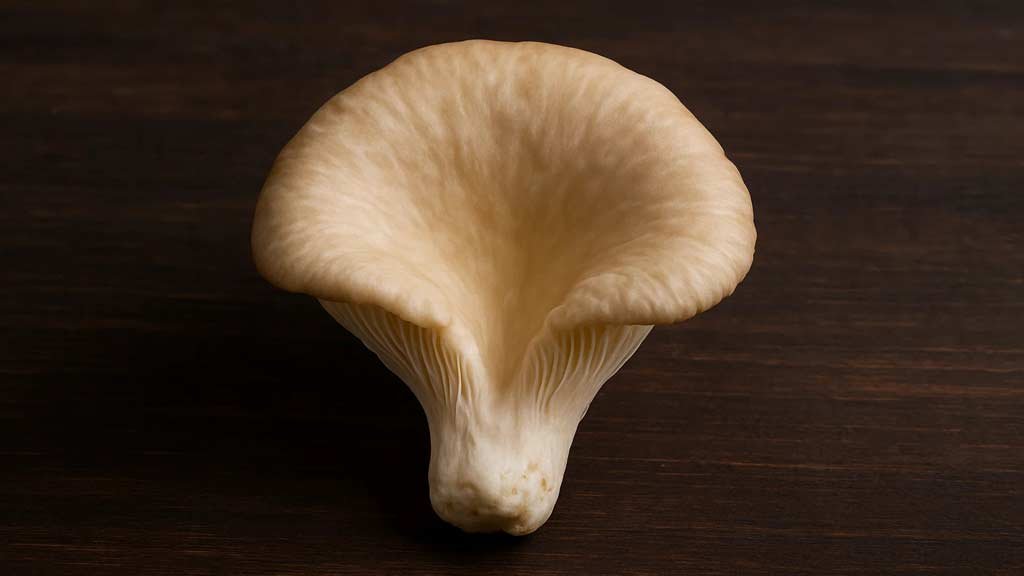A Mushroom That Feels Familiar Yet Surprising
Oyster mushrooms are everywhere once you start noticing them. They show up in farmers’ markets with their soft gray or white fans. They cling to fallen logs in the woods, growing in shelf-like clusters that look like something straight out of a storybook. They cook quickly, smell faintly sweet, and taste like a mix of earthy and slightly seafood-like—hence the name.
For many, oyster mushrooms are just a tasty addition to stir-fries or soups. But underneath that mild, approachable flavor is a mushroom with some serious potential for supporting heart health, immunity, and even metabolic balance. It’s one of those foods that quietly bridges the line between everyday cooking and herbal medicine.
Table of Contents
A Brief History in the Kitchen and Beyond
Oyster mushrooms (Pleurotus ostreatus) were first cultivated during World War I in Germany as a food source when rations were tight. They’ve since become one of the most widely grown edible mushrooms in the world. Easy to farm, adaptable, and fast-growing, they can thrive on agricultural waste like straw or sawdust. This resilience means they’re affordable and accessible almost everywhere.
Traditional uses go beyond filling the belly. In Chinese medicine, oyster mushrooms have been noted for their ability to “dispel wind” and strengthen the body. Today, researchers have taken interest in their bioactive compounds—especially polysaccharides, statin-like molecules, and antioxidants.
What Makes Oyster Mushrooms Special?
Unlike button mushrooms that fade into the background, oyster mushrooms bring more to the table. Their nutritional profile is solid:
- Rich in B vitamins (niacin, riboflavin, pantothenic acid)
- A natural source of ergothioneine, a rare antioxidant amino acid
- Good levels of potassium, iron, copper, and phosphorus
- Protein and fiber packed into a low-calorie food
But what really stands out are the unique compounds they produce:
- Beta-glucans: Complex polysaccharides known for stimulating immune activity.
- Lovastatin-like molecules: Naturally occurring statins that may help regulate cholesterol.
- Phenolic antioxidants: Compounds that fight oxidative stress in the body.
It’s a combination you don’t stumble across every day.
Heart Health: Nature’s Subtle Support
If you’ve ever had a doctor mention cholesterol, you’ve probably heard the word “statin.” Oyster mushrooms naturally produce lovastatin-like compounds, which can modestly inhibit cholesterol synthesis in the liver. That doesn’t mean a bowl of sautéed mushrooms will replace medication, but it does hint at why cultures that eat mushrooms regularly often show better cardiovascular markers.
Studies have observed that oyster mushroom extracts can:
- Lower total cholesterol and LDL levels in animal and human trials
- Improve lipid profiles without major side effects
- Provide antioxidants that help protect blood vessels from oxidative damage
I once met a retired chef in Hungary who swore by oyster mushrooms as his “heart food.” He’d fry them in a splash of sunflower oil, sprinkle on paprika, and insist they made him feel lighter after meals than meat did. Maybe it was partly the placebo effect, but science backs up his instinct.
Immune Benefits That Go Beyond Folk Wisdom
Beta-glucans found in oyster mushrooms are some of the most studied mushroom compounds for immune health. They don’t act like a blunt stimulant but rather as modulators—teaching the immune system to respond more effectively without overreacting.
In lab and animal studies, oyster mushroom polysaccharides have:
- Activated macrophages and natural killer cells
- Increased production of protective cytokines
- Enhanced the body’s defense against bacterial and viral infections
For everyday life, what does that mean? A stronger, more balanced immune system. You might not “feel” it working day to day, but there’s evidence that regular consumption could reduce susceptibility to infections and support recovery.
Metabolic Support and Blood Sugar Balance
Another quiet benefit of oyster mushrooms lies in their effect on blood sugar regulation. Certain studies suggest that the mushroom’s fiber, combined with its unique polysaccharides, helps blunt post-meal glucose spikes. For people managing prediabetes or type 2 diabetes, this can make oyster mushrooms a smart culinary ally.
The taste test makes it even easier. Unlike bitter herbs or pungent tonics, oyster mushrooms slide right into daily meals without fuss. A stir-fry with onions and garlic. A creamy soup with thyme. Even roasted until crisp and tossed on top of a salad.
Environmental Ally and Functional Food
Sometimes the context of a food matters just as much as the nutrients. Oyster mushrooms are masters of breaking down tough plant matter. In fact, they’re studied for their ability to degrade plastic waste and clean up environmental pollutants through a process called mycoremediation. That same talent for transformation is mirrored in their role as a functional food—helping humans metabolize fats, sugars, and free radicals more efficiently.
When you choose oyster mushrooms, you’re not just eating a tasty dish; you’re supporting one of nature’s great recyclers. It’s food that comes with a story of resilience and renewal.
Culinary Joys and Tricks in the Kitchen
Here’s the thing: medicinal or not, oyster mushrooms need to taste good to be worth eating regularly. Luckily, they deliver. Their silky texture when sautéed, their ability to soak up sauces, and their slightly oceanic aroma make them versatile.
A few tips:
- High heat is your friend. A quick, hot pan with a touch of oil brings out their best flavor.
- Don’t overcrowd. Give them space so they brown instead of steaming.
- Pair boldly. They stand up to soy sauce, garlic, chili, and herbs like rosemary or thyme.
- Crispy snack. Toss in a little olive oil and roast until crunchy—you’ll have mushroom “chips.”
I once tried oyster mushrooms smoked over applewood, and they tasted almost like bacon. A vegetarian friend served them at a barbecue, and half the guests didn’t even realize they weren’t eating meat until she told them.

How to Choose and Store Oyster Mushrooms
Fresh oyster mushrooms should look plump, not shriveled. The caps should be smooth and the gills creamy white. Avoid ones with slimy patches or a strong sour smell.
Storage tips:
- Keep in a paper bag in the fridge to prevent excess moisture.
- Use within 3–5 days for the best texture.
- For longer keeping, sauté and freeze or dry them for soups and stews.
The dried version concentrates their flavor, adding a deeper, more savory note to broths.
Precautions and Sensitivities
Oyster mushrooms are generally safe, but a few notes of caution:
- Some people experience mild stomach upset when eating them in large amounts.
- Rarely, individuals allergic to mushrooms may react.
- If you forage them, be certain of identification—though oysters are distinctive, mix-ups with inedible species can happen.
The Bigger Picture
Food doesn’t have to be either pleasure or medicine. Oyster mushrooms prove it can be both. They offer the simple joy of a pan of sizzling, golden edges and the quiet reassurance of compounds that protect the heart, bolster immunity, and steady metabolism.
They don’t shout for attention, but maybe that’s the beauty of them. They fit into life seamlessly, nourishing without fanfare.
Article Sources
At AncientHerbsWisdom, our content relies on reputable sources, including peer-reviewed studies, to substantiate the information presented in our articles. Our primary objective is to ensure our content is thoroughly fact-checked, maintaining a commitment to accuracy, reliability, and trustworthiness.
- Chang, S. T., & Wasser, S. P. (2017). The role of culinary-medicinal mushrooms on human welfare with a pyramid model for human health. International Journal of Medicinal Mushrooms, 19(2), 93–134. https://doi.org/10.1615/IntJMedMushrooms.v19.i2.10
- Jayakumar, T., Thomas, P. A., & Geraldine, P. (2011). Pleurotus ostreatus, an oyster mushroom, decreases oxidative stress in aged rat heart. Clinical and Experimental Pharmacology and Physiology, 38(6), 450–456. https://doi.org/10.1111/j.1440-1681.2011.05537.x
- Khatun, S., Islam, A., Cakilcioglu, U., Chatterjee, N. C., & Khan, M. A. (2012). Oyster mushrooms: A natural source of nutraceuticals and pharmaceuticals. International Journal of Medicinal Mushrooms, 14(4), 387–394. https://doi.org/10.1615/IntJMedMushrooms.v14.i4.70
- Patel, Y., Naraian, R., & Singh, V. K. (2012). Medicinal properties of Pleurotus species (oyster mushroom): A review. World Journal of Fungal and Plant Biology, 3(1), 1–12. https://idosi.org/wjfpr/wjfpr3(1)12/1.pdf
- Valverde, M. E., Hernández-Pérez, T., & Paredes-López, O. (2015). Edible mushrooms: Improving human health and promoting quality life. International Journal of Microbiology, 2015, Article 376387. https://doi.org/10.1155/2015/376387
- Wasser, S. P. (2014). Medicinal mushroom science: History, current status, future trends, and unsolved problems. International Journal of Medicinal Mushrooms, 16(1), 1–16. https://doi.org/10.1615/IntJMedMushr.v16.i1.10

